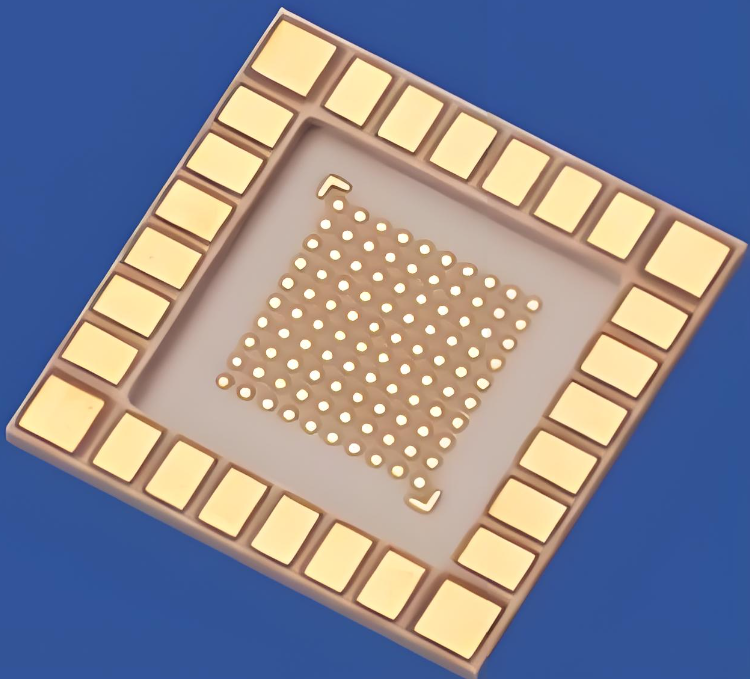Ceramic substrate PCBs are advanced printed circuit boards where the copper foil is directly bonded to a ceramic base, such as Aluminum Nitride or Alumina. This process occurs at high temperatures, ensuring a robust and thermally efficient structure. Depending on the design, these boards can feature copper layers on one or both sides, making them suitable for high-performance applications.

Ceramic Substrate PCBs
The Significance of Ceramic Substrates
Compared to conventional PCB materials like FR4 or aluminum, ceramic substrates offer superior electrical insulation, high thermal conductivity, and exceptional adhesion strength. These properties enable ceramic PCBs to handle higher current loads while maintaining structural integrity. Additionally, their resistance to harsh environmental conditions makes them ideal for high-power applications, including solar energy systems and high-intensity LEDs.
Types of Ceramic Substrates
Several ceramic materials are commonly used in PCB manufacturing, each offering unique advantages:
Alumina (Al2O3): The most widely used ceramic material in the electronics industry, alumina provides excellent thermal, mechanical, and electrical properties. Its high chemical stability and mechanical strength make it suitable for various industrial applications.
Beryllium Oxide (BeO): Known for its high thermal conductivity, BeO outperforms aluminum-based substrates in heat dissipation. However, due to its toxicity, its industrial applications are limited to specific high-performance thermal management solutions.
Aluminum Nitride (AlN): With an expansion coefficient closely matching silicon and exceptional thermal conductivity, AlN is a preferred choice for applications requiring efficient heat dissipation. However, strict material control is necessary to maintain its consistency, and its higher cost remains a limitation.
Among these, alumina remains the most widely adopted ceramic substrate, extensively utilized in power electronics, microelectronics, and hybrid circuits due to its excellent overall performance.
Manufacturing Techniques for Ceramic PCBs
PCB manufacturers employ several techniques to fabricate ceramic substrate boards, including:
Direct Bonded Copper (DBC): This process involves depositing copper onto the ceramic material using a eutectic solution of copper and oxygen at temperatures between 1065°C and 1083°C. The reaction forms a durable copper-aluminum oxide bond, ensuring strong adhesion.
Direct Plate Copper (DPC): Using vacuum or film manufacturing technology, copper is bonded to a ceramic base, then patterned and etched to create circuit traces. Electroplating further increases the copper thickness, enhancing durability.
Laser Activation Metallization (LAM): A high-power laser ionizes copper and ceramic, forming a strong bond. This method ensures superior electrical insulation, stable thermal expansion, and high-density assembly capabilities.
Thick Film Ceramic Technology: A paste of gold conductor material is applied to a ceramic base and baked at approximately 1000°C. While this process prevents oxidation and offers excellent reliability, the high cost of gold limits its widespread use.
Applications of Ceramic PCBs
Ceramic PCBs find extensive applications across various high-performance sectors:
Memory Modules: Used in DDR SDRAM and other computer memory applications.
Radar Systems: Essential for high-frequency transmission and receiving modules.
Semiconductor Cooling: Embedded with passive and active components for efficient heat dissipation.
Power Electronics: Utilized in electric power transmission, semiconductor devices, and solar panel applications.
LED Technology: High-brightness LED modules rely on ceramic PCBs for efficient thermal management.
Conclusion
Ceramic substrate PCBs represent the future of high-performance circuit board technology. Their superior thermal conductivity eliminates the need for additional heat sinks, making them ideal for semiconductor applications and high-power electronics. As the industry progresses, advancements in ceramic PCB manufacturing will continue to drive innovation in thermal management and electrical efficiency, ensuring their place in next-generation electronic devices.